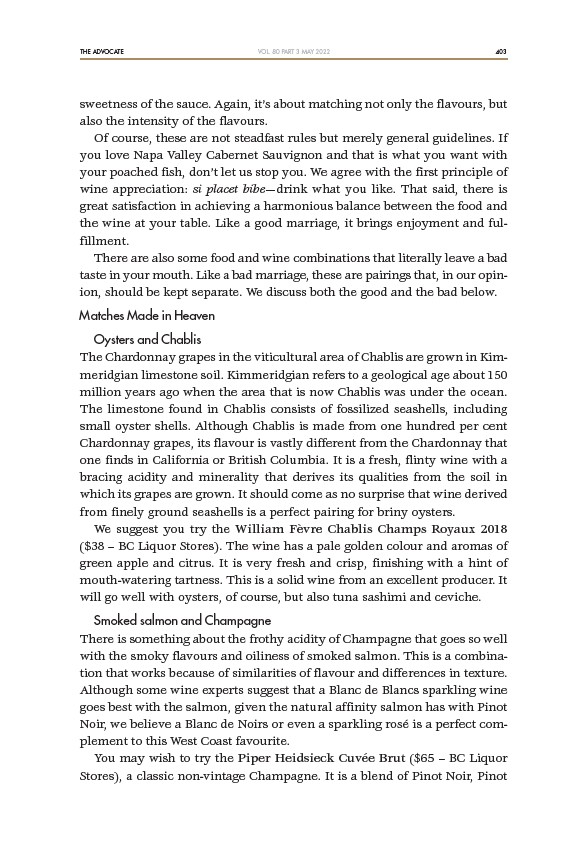
THE ADVOCATE 403
VOL. 80 PART 3 MAY 2022
sweetness of the sauce. Again, it’s about matching not only the flavours, but
also the intensity of the flavours.
Of course, these are not steadfast rules but merely general guidelines. If
you love Napa Valley Cabernet Sauvignon and that is what you want with
your poached fish, don’t let us stop you. We agree with the first principle of
wine appreciation: si placet bibe—drink what you like. That said, there is
great satisfaction in achieving a harmonious balance between the food and
the wine at your table. Like a good marriage, it brings enjoyment and fulfillment.
There are also some food and wine combinations that literally leave a bad
taste in your mouth. Like a bad marriage, these are pairings that, in our opinion,
should be kept separate. We discuss both the good and the bad below.
Matches Made in Heaven
Oysters and Chablis
The Chardonnay grapes in the viticultural area of Chablis are grown in Kimmeridgian
limestone soil. Kimmeridgian refers to a geological age about 150
million years ago when the area that is now Chablis was under the ocean.
The limestone found in Chablis consists of fossilized seashells, including
small oyster shells. Although Chablis is made from one hundred per cent
Chardonnay grapes, its flavour is vastly different from the Chardonnay that
one finds in California or British Columbia. It is a fresh, flinty wine with a
bracing acidity and minerality that derives its qualities from the soil in
which its grapes are grown. It should come as no surprise that wine derived
from finely ground seashells is a perfect pairing for briny oysters.
We suggest you try the William Fèvre Chablis Champs Royaux 2018
($38 – BC Liquor Stores). The wine has a pale golden colour and aromas of
green apple and citrus. It is very fresh and crisp, finishing with a hint of
mouth-watering tartness. This is a solid wine from an excellent producer. It
will go well with oysters, of course, but also tuna sashimi and ceviche.
Smoked salmon and Champagne
There is something about the frothy acidity of Champagne that goes so well
with the smoky flavours and oiliness of smoked salmon. This is a combination
that works because of similarities of flavour and differences in texture.
Although some wine experts suggest that a Blanc de Blancs sparkling wine
goes best with the salmon, given the natural affinity salmon has with Pinot
Noir, we believe a Blanc de Noirs or even a sparkling rosé is a perfect complement
to this West Coast favourite.
You may wish to try the Piper Heidsieck Cuvée Brut ($65 – BC Liquor
Stores), a classic non-vintage Champagne. It is a blend of Pinot Noir, Pinot